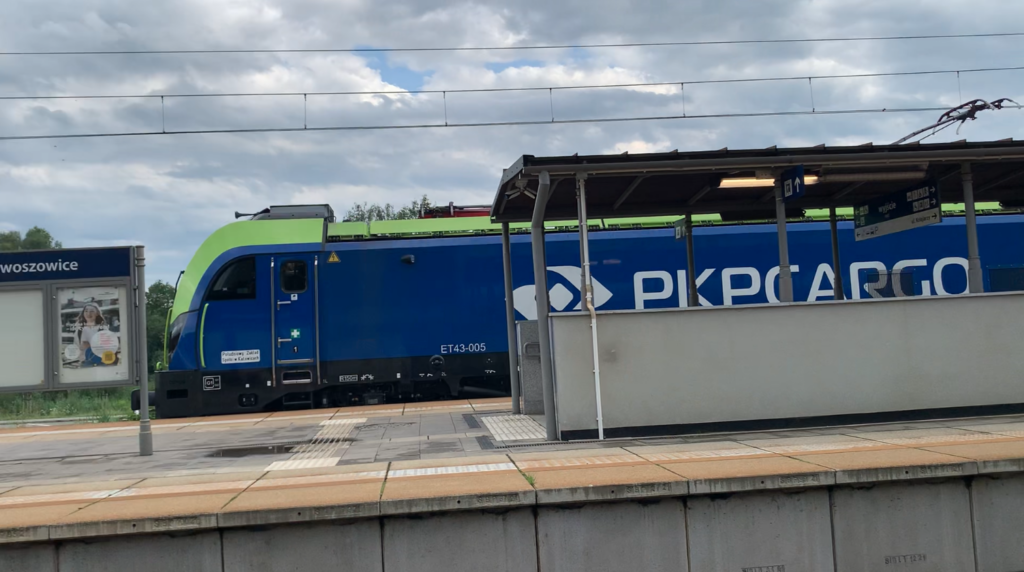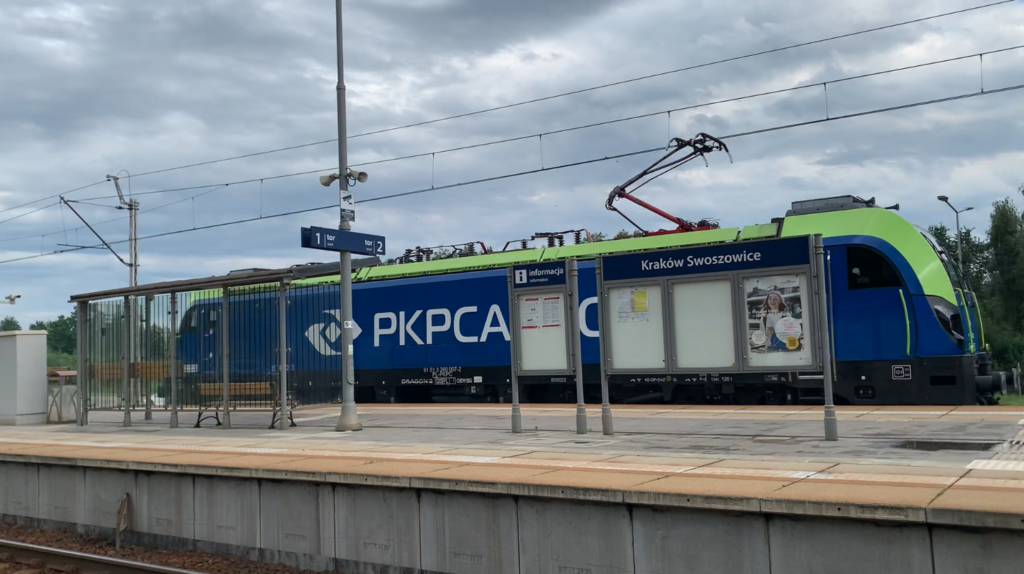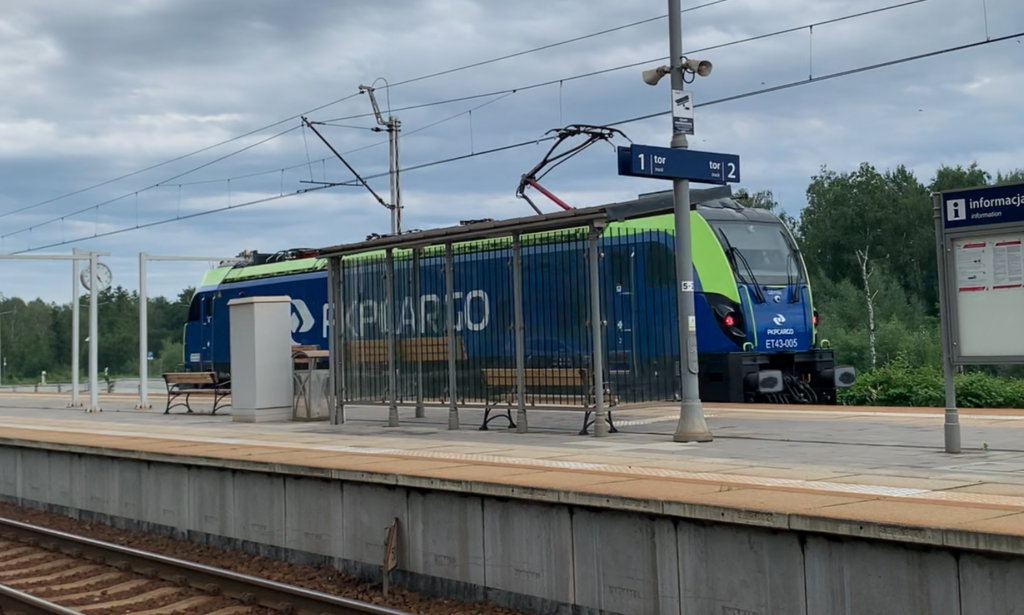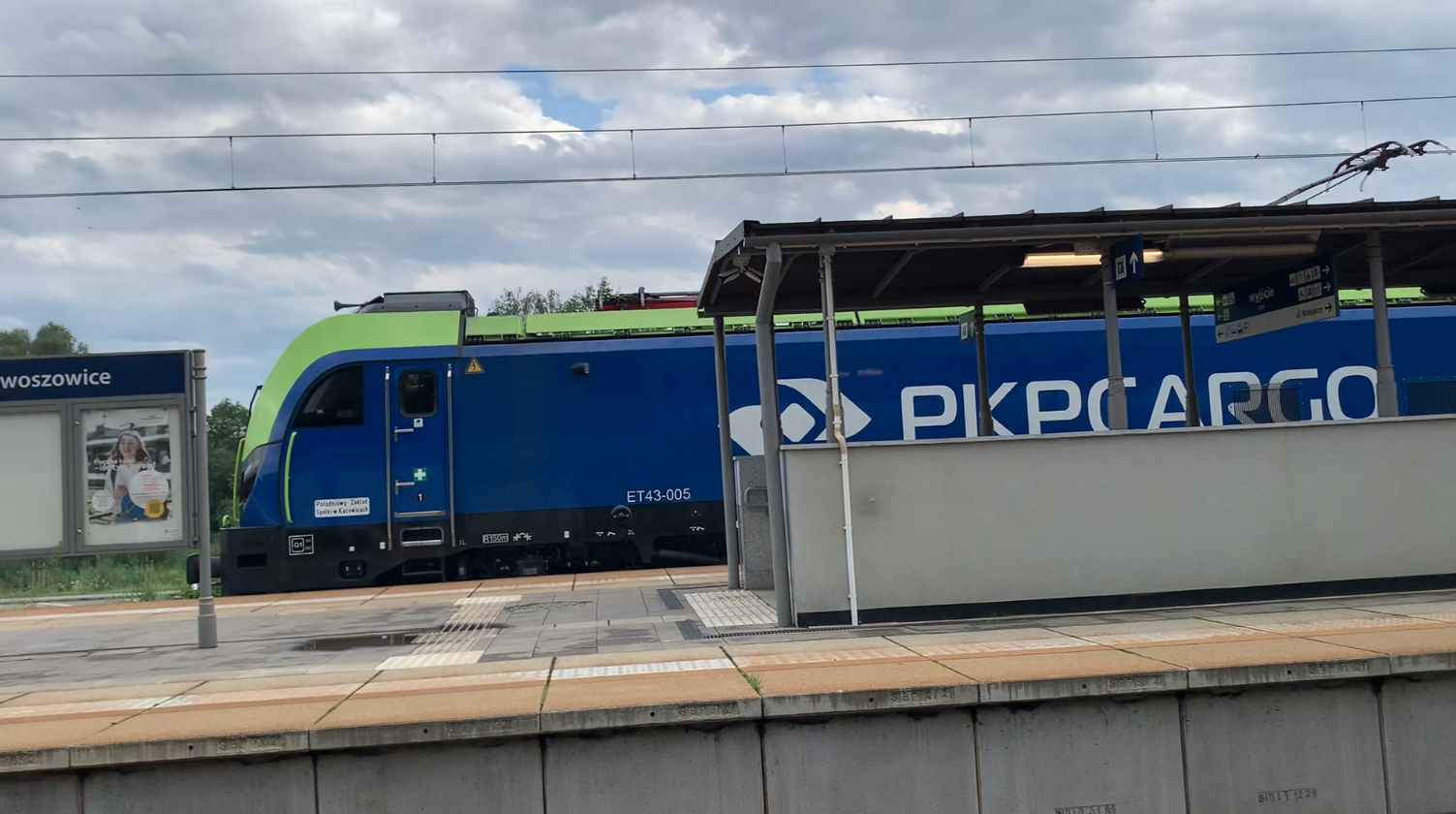Kraków 2024-01-18
NEWAG ET43-005 Dragon 2 electric freight locomotive.



Newag Dragon is a family of six-axle electric locomotives designed to pull heavy freight trains weighing up to 4,500 tons. Dragon, or “Smok,” is the popular trade name for this locomotive. Dragon represents a new standard among freight locomotives, particularly suited to Polish conditions. The E6ACT Dragon locomotive is also designated ET25 by PKP and ET43 by PKP Cargo, and is the first new Polish freight locomotive after the ET22, whose production ended in 1989. Dragon is characterized by high tractive effort of up to 374 kN, operational safety, attractive pricing, economical operation, extensive equipment, and reliability.
The first Dragon locomotive was built in 2009 at ZNLE Gliwice. The Electric Locomotive Repair Plant was built in cooperation with NEWAG, based in Nowy Sącz. From 2009 to 2016, the Newag Dragon locomotive was manufactured by NEWAG Gliwice, and from 2017 by Newag Nowy Sącz. By 2021, a total of over 50 locomotives in numerous versions had been produced, all of which are operated by Polish freight carriers.
Development of the Dragon design.
The basic locomotive in Poland was the ET22, of which 1,207 were built by PaFaWag in Wrocław until 1989. Then, until 1997, EP09 passenger electric locomotives were built there. Polish-Italian universal dual-mode EU43 and single-mode EU11 electric locomotives were also produced. Production continued until 2002, when the PaFaWag plant was closed and the Adtranz company took over. However, these electric locomotives did not enter Polish service because they were too expensive. In 2002, the Adtranz-PaFaWag factory was taken over by Bombardier, which decided not to produce complete electric locomotives at the Wrocław plant. As a result, since 2002, there has been no electric locomotive manufacturer in Poland.
This situation was unacceptable to Poland. In 2006, the Ministry of Science and several research and development institutions decided to develop a new Polish electric locomotive for heavy freight trains. At the same time, it was intended to be capable of operating on more worn tracks, so the locomotive was designed with a Co-Co-axle configuration. New traction motors were also designed. The first locomotive is powered by six STX500-4A electric motors (manufactured by EMIT) with an output of 834 kW each. Subsequent units use ABB AMXL450 motors with an output of 837 kW.
In 2009, the E6ACT-001 Dragon prototype was presented at the Trako railway fair in Gdańsk. It was the first Polish locomotive since 1990, when the EM10 (HCP 405E) locomotive premiered. In 2010, tests of the Dragon locomotive began on a test track near Żmigród in Lower Silesia. In 2010, the locomotive was unveiled at the InnoTrans trade fair in Berlin. It received approval for rail traffic in Poland. In 2011, transport companies such as STK, PKP Cargo, Pol-Miedź Trans, Lotos Kolej, and Freightliner were already interested in the locomotive.
The success of the Dragon locomotive, coupled with changes in regulations, led to the development of the Dragon 2 version in 2018. The first locomotive of this version was designated E6ACTa-001. The locomotive successfully passed tests and received a certificate. Dragon 2 is the first Polish locomotive equipped with SiC (silicon carbide) power electronics, meaning it is equipped with an auxiliary power converter called PSM-175 SiC, developed and manufactured by Medcom. The reason for designing the new Dragon 2 version was the change in TSI regulations.
The Dragon locomotive’s modular design allows for a build that best meets the customer’s needs and reduces repair and maintenance time. The standard tractive effort is 374 kN, but thanks to modern technologies, this can be increased to 450 kN (MAX LOAD option). The locomotive can be built for customers using electric traction powered by 25 kV/15 kV AC. The locomotive can be equipped with an additional diesel drive (DUAL POWER option), which allows it to be operated on non-electrified sidings. The locomotive’s design focuses on driver safety and comfort. The driver’s cabs feature a crumple zone and a closed cage layout. The cage-style driver’s cab is equipped with a touchscreen panel. Instead of rearview mirrors, four cameras are used, and their images are displayed on a monitor. Two additional cameras provide a view of the locomotive’s couplers. The locomotive offers the option of installing a closed toilet. The locomotive features an advanced electronic diagnostic system. The engine compartment is modular, simplifying repairs and reducing maintenance time. In its basic version, the locomotive weighs 119,000 kg. The locomotive has a modern anti-slip system. Thanks to its six axles, the axle load does not exceed 20,000 kg. The locomotive has a wheel flange lubrication system, which increases the service life of the wheelsets and rails, especially in tight curves, and works very well in Polish conditions.
The Dragon electric locomotive is powered by asynchronous motors powered by IGBT converters. The wheel diameter is 1.25 m. Initially, STX500-4A motors with a power output of 834 kW each were used, followed by ABB AMXL450 motors. Disc brakes are used. Each axle is mounted in tapered roller bearings. Each axle is equipped with a temperature and speed sensor.
Currently (2021), Dragon locomotives are offered in the following versions:
Dragon DC: DC supply voltage 3 kV. Continuous power 5 MW. Maximum speed 120 – 140 km/h. With a train weighing 3,200 tons, the speed is 115 km/h. Starting tractive effort 374 kN, 450 kN with the MaxLoad option. Locomotive length over buffers: 20.33 m. Width: 3.00 m. Height: 4.32 m.
Dragon AC: Supply voltage: AC 15 kV 16 2/3 Hz, AC 25 kV 50 Hz. Continuous power: 5 MW. Maximum speed: 120 km/h. Starting tractive effort: 374 kN, 450 kN with the MaxLoad option. Locomotive length over buffers: 20.33 m. Width: 3.00 m. Height: 4.32 m.
Dragon MS: DC 3 kV, AC 15 kV 16 2/3 Hz, AC 25 kV 50 Hz. Continuous power: 5 MW. Maximum speed: 120 km/h. Starting tractive effort: 374 kN, 450 kN with the MaxLoad option. Locomotive length over buffers: 20.33 m. Width: 3.00 m. Height: 4.32 m.
Dragon DIESEL: Internal combustion engine. Continuous power: 2.3 MW. Maximum speed: 120 km/h. Starting tractive effort: 370 kN. Locomotive length over buffers: 20.33 m. Width: 3.00 m. Height: 4.32 m.
ET43 NEWAG Dragon 2 electric locomotive.
The Dragon 2 electric locomotive is the first 6-axle electric locomotive in Europe, fully compliant with the Technical Specifications for Interoperability (TSI 2014), which were issued in 2014. The locomotive is equipped with ETCS Level 2. Series production began in 2018.
The type designation E6ACTab / E6ACTAd denotes: E – electric locomotive, 6 – six-axle, AC – with alternating current motors, T – for freight transport, a – second generation compliant with the TSI, d – with a diesel access module, b – ETCS system based on baseline 3.4.0. Since 2009, the European Train Control System (ETCS), a rail traffic control system compatible across Europe, has been installed on the CMK (Central Main Line). This was a Level 1 system. Approximately 1,200 track ballistae (electronic devices, including counters, analysis, and testing systems) were installed. In 2011, PKP (Polish State Railways) conducted tests of the ETCS system using an EU44 Husarz locomotive. On November 21, 2013, the President of the Office of Rail Transport approved its operation.
The ETCS system allows for automated train operation, thereby increasing safety. The system operates by communicating with track-mounted devices and generating information, such as the maximum permitted speed on a given section. ETCS monitors the driver’s response to transmitted messages and reacts if the “STOP” signal is ignored, which in turn ensures improved driving safety. Its operation is based on so-called cab signaling, which allows for visualization of the situation on the railway line, instead of solely on semaphores, as was previously the case. The permitted speed on a given section of the railway line is displayed on a display in the driver’s cab. This allows for appropriate response and adaptation of the train to the prevailing conditions, while also eliminating potential errors, such as those resulting from a lack of visibility of the semaphores.
In 2020, a dual-mode Dragon 2 ET43-001 locomotive was built for PKP Cargo and sent for testing. It was then sent to the Czech Republic for further testing. The locomotive is equipped with silicon carbide (SiC) converters, ensuring trouble-free operation at high temperatures, reduced noise levels, a 50% reduction in energy losses, and a 60% reduction in the size and weight of the equipment. The locomotive is designed to haul freight trains weighing up to 3,200 tons and passenger trains weighing up to 800 tons. Asynchronous electric motors are used in the locomotive. The vehicle is equipped with a diagnostic system with full visual information and a data logging module. The locomotive is compatible with ERTMS and GSM-R equipment. The vehicle features spacious cabins compliant with EN 1527 standards, ensuring a high level of comfort for the engineer.
The bogies feature monobloc wheels with a diameter of 1.250 m. Brake discs are mounted on both sides of the wheel. The traction motors are asynchronous, squirrel-cage, with a power output of 1,400 kW each. Each motor has independent cooling. The gears have helical gear teeth to reduce noise. Speed and temperature sensors are mounted on each axle. The locomotive is equipped with a fire detection and extinguishing system.
Springing: First stage: two sets of coil springs mounted directly on either side of the axlebox. Second stage: a set of large-sized “flexicoil” spiral springs. Hydraulic shock absorbers provide vibration damping.
The locomotive body is a self-supporting welded structure. Crumple zones and a safety cage for the driver’s cab are incorporated. The service corridor is located in the center of the vehicle. The cabin air conditioning is two-module. Four cameras serve as exterior mirrors, and two more provide images of the couplers.
High-voltage (HV) electrical circuits: The locomotive has two or four half-circuit current collectors with their own control system and auto-drop system. A Secheron UR26 high-speed circuit breaker is used. Low voltage electrical circuits: 24 V DC obtained from an additional battery charger powered by 3×440 V. Power supply: control circuits, high-speed circuit breaker, measuring converter control system, battery charging system, control panel devices, pneumatic system control, internal and external lighting, windshield wipers. Top-class 335 Ah batteries are used, manufactured using FNC fiber technology.
Newag Dragon 2, ET43-005.
Newag Dragon 2 ET43-005 has factory number E6MST-005, registration number EVN: 91 51 3 260 007-2 (PL-PKPC). The locomotive was built in August 2021. Plant tests were performed in September 2021, together with locomotives ET43-002 and ET43-003. Locomotive ET43-005 was included in the tests. On March 22, 2023, the locomotive was taken over by PKP Cargo Południowy Zakład Spółka in Katowice. The locomotive received a certificate for railway lines in Poland, the Czech Republic, and Slovakia (ERA homologation). In May 2023, the locomotive was hired to pull train EIC 48/17005 on the Warsaw-Berlin route, replacing the broken-down EU44-005 locomotive.
Axle arrangement: Co’Co’. Supply voltage: 3 kV DC / 25 kV AC. Maximum speed: 120 km/h. Standard gauge: 1,435 mm. Weight: 119,000 kg. Axle load: 20,000 kg/axle. Length: 20.33 m. Monoblock wheel diameter: 1.25 m. Gauge: UIC 505-1. Continuous power: approximately 5,000 kW. Maximum tractive effort: up to 420 kN as standard (Max Load version: up to 450 kN). Electric motors: 6 asynchronous motors, each with a power output of approximately 842–834 kW. Capable of hauling loads up to 4,000 tons. Up to 4,500 tons with the Max Load option.
Written by Karol Placha Hetman
